JAXA and NASA hold their second workshop on ISS utilization!
Last Updated:
September 26, 2017
As part of the Japan-US Open Platform Partnership Program (JP-US OP3*), a joint effort uniting the governments of Japan and the United States, JAXA and NASA held a workshop on International Space Station (ISS) utilization on July 17. The workshops provide a forum for showcasing a variety of topics, such as the utilization strategies and achievements of JAXA and NASA and the experimentation environments available at both research organizations, to help generate and maximize the benefits of utilizing the Kibo module and the ISS as a whole.
*The governments of Japan and the United States signed an agreement in December 2015 to launch JP-US OP3, a new collaborative framework for the extension of ISS operations through 2024.
Rundown of the JAXA/NASA joint workshop
Date: July 17 (Mon.), 2017
Location: Washington, DC (USA)
Participants: Approximately 200 participants, mostly potential users from the United States
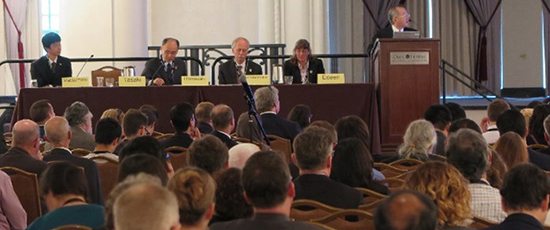
JAXA/NASA joint workshop (Credit: JAXA)
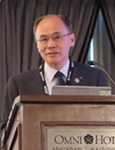
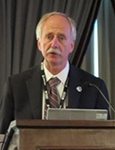
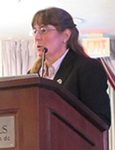
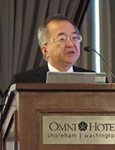
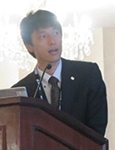
(from left) Takashi Hamazaki (Vice President, Director General, Human Spaceflight Technology Directorate, JAXA), William Gerstenmaier (Associate Administrator, NASA), Marybeth Edeen (Research Integration Office Manager, NASA), Kazuyuki Tasaki (Head of the Kibo Utilization Center, JAXA), Kunihiro Matsumoto (Senior Technician, JEM Small Satellite On-orbit Deployer) (Credit: JAXA)
Overview
At the workshop, the second in a series that began last year, JAXA’s Takashi Hamazaki (Vice President, Director General, Human Spaceflight Technology Directorate) and NASA’s William Gerstenmaier (Associate Administrator for the Human Exploration and Operations Directorate) voiced their expectations that the JAXA/NASA utilization partnership would continue to accelerate and produce outstanding results. The two also spoke about hopes for more opportunities for expanded utilization as the collaborative utilization community continues to develop. (*See below for full transcripts of the addresses )
NASA presentation (summary)
NASA expressed its gratitude that the JP-US OP3 gives US users access to unique JAXA experimentation facilities that previously have been unavailable for NASA use. Moving forward, the NASA spokesperson explained, both JAXA and NASA need to work to create more opportunities for utilization in hopes of maximizing the benefits coming from the ISS.
JAXA presentation (summary)
- JAXA successfully completed its first mice-based testing via newly developed equipment capable of generating partial-g environments.
Under this special arrangement between Japan and the United States, access provision is taking a higher priority. - JAXA is also working on outboard equipment. One approach involves providing paid access to an experiment platform (featuring a mid-size exposure experiment adapter, simplified exposure experiment system, and the JEM Small Satellite On-orbit Deployer) that delivers high-frequency performance in small and mid-size applications to make the Exposed Facility more user-friendly.
Rundown of the ISS R&D Conference
Dates: July 18 (Tue.)-20 (Thu.), 2017
Location: Washington, DC (USA)
Sponsors: NASA, CASIS*1, and AAS*2
Participants: 1,035 registered participants over three days (compared to approximately 700 last year)
*1: The Center for the Advancement of Science in Space (an American NPO)
*2: American Astronautical Society
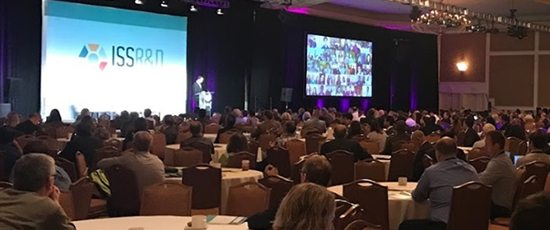
ISS R&D Conference (Credit: JAXA)
Overview
- Plenary panel (approximately 300 participants)
- Speakers: 4
NASA: Kirk Shireman (ISS Program Manager)
CASIS: Greg Johnson (Executive Director)
AAS: Carol Lane (President)
US Representative Brian Babin (Member of Congress) - Details:
The gathering gave new users information on the outcomes and merits of ISS utilization and fostered discussions about efforts to maximize the benefits of the ISS.
- Speakers: 4
- Japan’s JEM Small Satellite On-orbit Deployer Team wins an ISS Research Award!
The event featured a total of seven presentations, including several technical sessions, providing attendees with information on Kibo utilization benefits and Japan-US collaboration under the JP-US OP3 arrangement. The JEM Small Satellite On-orbit Deployer platform, which uses JAXA’s Kibo module, took home one of eight ISS Research Awards. Japanese projects have now garnered ISS Research Awards for two consecutive years.
<ISS Research Award>
I. JEM Small Satellite On-orbit Deployer(J-SSOD)
Winner: Kunihiro Matsumoto (JAXA)
Joint prize winners
– Hiroki Akagi (JAXA)
– Masaru Wada (JAXA)
– Takayuki Sato (JAXA)
Full text
Full text of the address by Takashi Hamazaki
(Vice President, Director General, Human Spaceflight Technology Directorate)
In December 2015, the Japanese and US governments announced the Japan-US Open Platform Partnership Program (JP-US OP3). OP3, which requires NASA and JAXA to develop new collaborative initiatives via ISS utilization, charges the two organizations with the task of showing the respective governments new efforts that stretch beyond the possibilities of the existing arrangement. To push OP3 ahead, we are currently at work on a new collaboration plan defining rules, guidelines, and other matters.
Last year, the ISS R&D community held a workshop for US users in an effort to propel OP3 forward. Today’s event is the second such workshop, furthering an initiative that we hope to continue with a similar gathering in Tokyo this coming November.
Since last year, JAXA has been taking advantage of Kibo’s unique capabilities to generate a variety of remarkable results. We are now promoting the use of promising components for utilization, such as our PCG and Exposed Facility.
We also successfully completed our first-ever mice-based experiments using our newly developed Mouse Habitat Unit and our very own system for creating partial-g environments. Given the importance of the new, unique Mouse Habitat Unit to Japanese researchers, we were not originally planning to give international partners access to the technology through the existing framework. Under the special OP3 arrangement between Japan and the United States, however, we are making collaborative utilization a higher priority (through fair, reciprocal exchange in accordance with the collaboration plan).
We developed i-SEEP and other unique systems to make Kibo’s Exposed Facility more user-friendly, as well. For details on these systems, which are also available for commercial use, visit booth 22.
Utilization of these onboard and outboard facilities will undoubtedly enhance the value of the ISS and produce tremendous benefits. I hope that today’s workshop accelerates Japan-US collaboration on the ISS and the Kibo module.
Full transcript of the address by NASA’s William Gerstenmaier
(Associate Administrator for the Human Exploration and Operations Directorate)
Good afternoon. I’m delighted to be here today with Mr. Hamazaki and our Japanese colleagues to make some opening remarks at this second JAXA/NASA joint workshop. It is truly exciting to see so many people interested in using the ISS and understanding the unique capabilities of the Kibo module for pressurized payloads and unpressurized payloads.
The Japan-U.S. Open Platform Partnership Program, or OP3, enables U.S. investigators access to JAXA facilities that may previously have been unavailable for NASA use. Our JAXA colleagues have some very unique hardware capabilities that are not available anywhere else in the ISS partnership. These include things like as rodent centrifuges, aquatic habitats and high temperature material property testing capability. Today you will hear some details about these and other capabilities.
NASA’s priority is for joint scientific research that enables investigators to use both NASA and JAXA ISS facilities, focusing on expanded research for all, and to demonstrate the many ways we are advancing our OP3 goals. As you listen to our JAXA colleagues describe the unique facilities they bring to the ISS, be thinking about what types of questions and discoveries could be made. As we all work together to maximize the research and benefits coming from the ISS, NASA and JAXA are ready to work with the U.S. research community to enable access to these one of a kind facilities.
I want to thank our Japanese partners for making these opportunities available and hope that this partnership expands the research opportunities for all researchers. JAXA has continued to improve capabilities and access opportunities for researchers from the workshop that was held last year. Mr. Hamazaki and his team will show you through several presentations examples of the research made possible through these unique facilities. JAXA has a tremendous research capability on ISS and continuing to improve that capability.
Comments are closed.